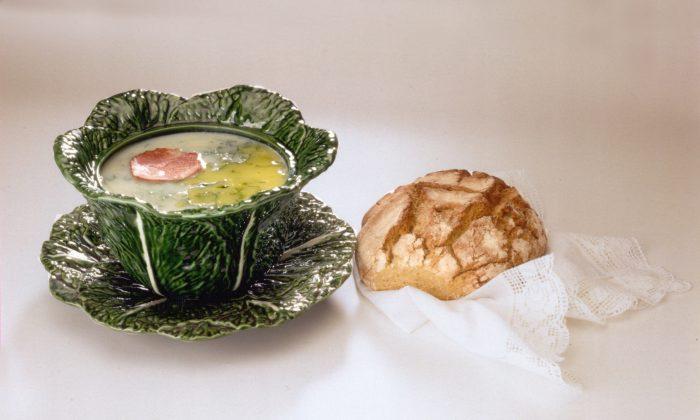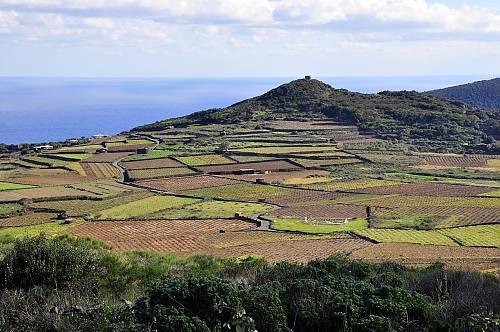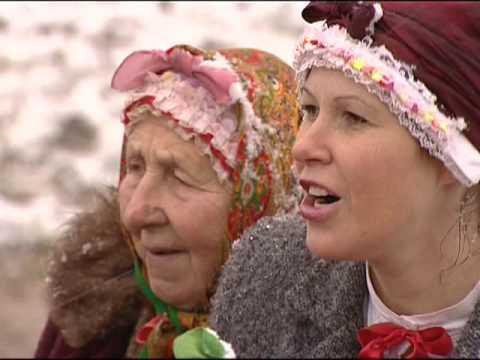What could more appropriately express the spirit of the holiday season than an epicurean holiday bread to have on hand when family and friends get together? That, along with feasting on salt cod and caldo verde (kale and potato soup), eating sugarplums (candied fruit) just like the ones that dance through children’s heads on Christmas Eve, and a nice bushy evergreen tree are what make the season festive for Portuguese-Canadian families.
The Portuguese were the first Europeans to cook with potatoes and many of their favourite holiday foods are combinations of potatoes and fish, such as bacalhau a gomes de sa, which includes onions and black olives. Many families serve this dish after midnight Mass, followed by an exchange of gifts. Santa Claus makes his appearance in the early morning hours. On Dec. 25 there is a special meal that includes turkey, cranberry sauce, and Bolo de Rei in memory of the gifts the Magi presented.
Caldo Verde
4 potatoes, peeled
40 ml (3 tbsp) olive oil
2 L (8 cups) water
Salt and pepper to taste
900 g (2 lbs) kale
250 g (1/2 lb) smoked garlic sausage, cooked
Prepare potatoes, slicing them thinly. Combine with olive oil and water and cook for 30 minutes or until soft. Put through a sieve and return to liquid. Season and simmer for half an hour. Wash kale, throwing away tough leaves and ribs, and then shred. Add to potatoes and cook for another half hour. Add cooked, sliced sausages. Serves six.
Bolo de Rei (King’s Cake)
125 ml (1/2 cup) candied citrus fruit
125 ml (12 cup) pine nuts
40 (3 tbsp) raisins
75 ml (1/3 cup) plus 25 ml (2 tbsp) Port wine
12 ml (2 1/2 tsp) active dry yeast
75 ml (1/3 cup) milk plus another 10 ml (2 tsp)
875 ml (3 1/2 cups) unbleached flour
5 ml (1 tsp) salt
35 ml (7 tsp) unsalted butter, softened
75 ml (1/3 cup) plus 10 ml (2 tsp) sugar
Zest of 2 oranges, grated
3 eggs, beaten
1 fava bean and a large coin
Topping:
1 egg yolk, beaten with 5 ml (1 tsp) water
125 ml (1/2 cup) walnuts
10 candied cherries
1 package natural Medjool dates
Powdered sugar for dusting top
Soak candied fruit, pine nuts and raisins in wine overnight. Sprinkle yeast into milk in bowl and let rest five minutes. Stir to dissolve yeast. Mix flour and salt in a large bowl, make well in the centre and pour in the yeast. Use a wooden spoon to swirl enough flour into dissolved yeast to form a light paste. Cover with a tea towel. Let stand until frothy and slightly risen, around 25 minutes.
Beat butter and sugar with orange zest and then the eggs, one at a time, beating after each addition. Add to flour mixture and mix in flour from sides of the bowl. Turn out and knead until soft, smooth, and elastic, about 10 minutes. Add fruit and nuts. Place in a clean bowl and cover with a tea towel. Let rise in a warm place until doubled, at least two hours. Punch down and let rest for ten minutes. Shape into a ring and place on buttered baking sheet. Wrap fava bean in waxed paper and then the coin. Bury in the bottom of the bread. Cover and let rise for another hour.
Topping: Brush dough with egg glaze and decorate with walnuts, dates and cherries.
Bake at 180º C (350º F) for about 45 minutes or until golden. Cool and dust with powdered sugar.
Susan Hallett is an award-winning writer and editor who has written for The Beaver, The Globe & Mail, Wine Tidings, and Doctor’s Review, among others. She is currently the European editor of Taste & Travel International. Email: [email protected]






Friends Read Free